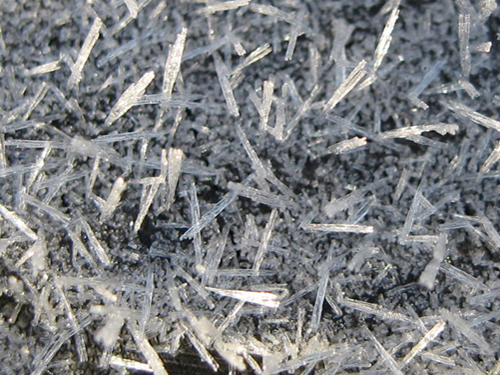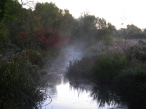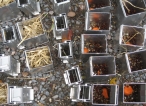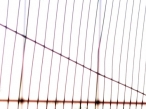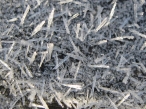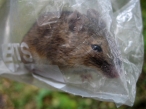
Four walks around a year: autumn | Sebastiane Hegarty
winnall moors soundwalk
GrDl 140 | Gruen Digital > [order]
MP3 & FLAC
The autumn sound walk opens quietly at the dawn of the autumnal equinox, when day and night are of equal measure. Such a lull in progression solicits remembering and reverie, time thickens and the present and previous associate. Fragments of voice litter the soundscape, allowing splinters of human narratives to inhabit this remembered landscape. The notion of a sound walk implies a sense of narrative, a physical momentum and movement through a soundscape: a rhythm and succession of sounds, leading and accompany the listener through a place and time. Although the autumn field-recordings form a seasonal diary from which the walk is composed, the chronology of the recordings does not restrict or determine the direction or progress of transit. The recorded hours of walking and listening were allowed to amble, recomposing a walk that never took place: a remembered journey through the sounds of a forgotten landscape.
There is a particular quality to the acoustics of autumnal water, which makes it distinct from the river and rainfall of summer. These qualities are present, not only in the explicit percussion of rainfall on the carpet of dry leaves, but also in a less distinct, almost synaesthetic change in the timbre of wetness, which, although gentle, becomes sharp and slightly angular.
The emptiness of the autumn soundscape is palpable, especially when preceded by the fecund chorus of spring and summer. A sense of distance seems to saturate a pallid landscape punctuated by small sonic details. Sound is intermittent, a foggy silence hangs in the air, interrupted by the occasional Hammer Horror squeal of a water rail or the sudden gravel and viscose chaff of a runner approaching, arriving and vanishing.
For the conservation team, autumn is suited to survey and repair. A lack of procreation means that breeding animals are less likely to be disturbed and the environment can be scientifically assessed: The water vole population is at its highest and the small mammal survey is less likely to harm pregnant females. This survey introduces it’s own percussive spatiality, as the traps, laid with seeds, fly larvae and straw, offer up sharp oblongs of reverberation.
The labour of repair introduces it’s own abstract qualities, extending an otherness to the spatiality and temporality of the world apprehended. In reforming the riverbed, using shingle to improve the subaquatic landscape for breeding trout, we hear the acoustic sculpture of form and substance: a rock thrown into the river, hollows out a sudden wet baseline; the cascade of shingle provides a curtain of damp percussion, whilst the gargling diesel engine of a tractor, retreats and disappears into the silence of distance.
Emergencies repairs to a collapsed hatch, which takes water from the River Itchen into the mini-stream and out across the reed-beds, result in a temporary interruption to the soundscape. The paths are closed with wire fences placed across the boardwalk and path at the rugby-field bridge. An area of sound is temporarily shut, but by attaching contact microphones to these fences we are allowed audible access to the Musique concrète of air caught in a net of wire and the echoing gait of people walking over the bridge. Into the moors and these dark reverberations, drifts the public address of Bonfire Night and the invisible static constellations of fireworks: a tiny big bang of acoustic space and a hardy annual soundmark in the autumnal soundscape of winnall moors.
sound descriptors: a list of sounds as they appear on the autumn walk
Dawn chorus on the autumn equinox, footsteps on the first crystals of frost, mini-stream, swans dipping and feeding, water rail railing, dog calling, flight path, breeze of dry reeds, water vole survey, water waders, small mammal survey, preparing traps, paddles and Sunday canoes, raft of ducks, mini-stream, prayer-bell, breeze through a metal fence, rain on leaves, bonfire night, public address, steps on leaves, rain on water, latch, low of cows, stones thrown in a river, tractor approaching, pouring gravel, sculpting a river, reeds in stream, blackbird evening alarm, snow steps, creaking ice cracked.
Background
The Winnall Moors soundwalk project was made in collaboration with Hampshire Wildlife Trust (HWT). The project began in the winter of 2010, with the aim of creating a soundwalk based on recordings made in the Winnall Moors conservation reserve over the period of one year. Extending the recording process over this timescale, allowed the discrete temporal patterns of the landscape to become apparent. The inclusive nature of the sounds collected, reflect both the complicated topography of the reserve, which is at once a shared public space, a historic and natural landscape and an area of encircled wilderness.
As the project progressed, it became apparent that composing one soundwalk for the whole year would be restrictive. It seemed more appropriate for there to be four walks, responding to individual acoustic character of the years celestial quarters: winter, spring, summer, autumn. The temporality of the sonic environment is reflected not only in the migratory, seasonal wildlife sounds, but also in the calendars of local, human and conservation activity.
The duration of each soundwalk is set at twenty-five minutes, which roughly corresponds to the time it takes to walk a full circuit of the moors reserve. For the purposes of the HWT, the soundwalks provide a form of poetic audio guide; a sort of headphone transit, that may allow the previous and present sonic landscape to intertwine.
I would like to extend my sincere thanks to all the employees, wardens, scientist and volunteers at the Trust and in particular, Martin De Retuerto, Rachel Remnant and David Eades for their help, inspiration and support.
1 Track (25′01″)
Field Recording Series by Gruenrekorder
Gruenrekorder / Germany / 2013 / GrDl 140 / LC 09488
Richard Allen | a closer listen
How well do you know the soundscape of your own neighborhood? Are you in tune with the seasonal changes, the cries of different birds, the direction in which they migrate, the flow of local river banks and drainage systems? Do you know when the neighbors come home from work and when their children leave for school? Do you know their names, or the names of the trees in your yard, or the thickets that grow behind them? What creatures live on your property, and what sort of sounds do they make? Where do they go in the winter ~ do they migrate, burrow, or die?
These are the sort of questions that interest Sebastiane Hegarty, whose series Four Walks Around a Year has just drawn to a close. His 25-minute walks around the Winnall Moors Preserve have now been captured for all generations, one recording for each season, each recording combining the sounds of multiple forays. Gruenrekorder’s website provides an elaborate description of the walks, along with complete lists of identifiable sounds: much more than one might guess without prompt. When listening to the project in full, one experiences an entire year in a hundred minutes.
05Here’s the sound of footsteps on hardened ground, and birds singing their joy at the returning sunlight. It’s spring in the reserve, and there’s plenty of life in the moors. The African warblers have just returned; the workers are at their posts; the water is flowing freely in the river. Human equipment can be heard in the distance, never far from nature. Spring is a time to check the reserve and to see what has survived. Has the winter been harsh? Have all of the residents made it through? Has the grass received enough moisture to sprout? The people sound as happy as the birds. The layers are being shed, the windows are being opened, the populace is venturing outside. Children are gathering, crying, playing. ”Don’t drop it on its head!” warns an amused gentleman; hopefully the child has not captured a swan.
06Will summer be different? Indeed. Again we begin with footsteps and birds, but the soundscape has subtly changed. Hegarty refers to the turnover as “calendars of sounds”. Summer adds grasshoppers and wasps, ice cream trucks and active construction. A brief downpour affects the river and the leaves. As the initial burst ends suddenly, one remembers that this is not a single walk, but a patchwork; sounds are moved around in order to highlight their properties. Hegarty also writes about the absence of sound: “the ghosts of sounds no longer here.” It’s harder to hear what’s absent than what’s present, but the release trains us to concentrate and remember. The different timbres of precipitation make this the most immediately compelling of the walks, but “Wednesday evening bell practice” contributes an especially lovely angle. No offense to humans, but the lessening of voices in the summer walk is a draw as well.
02To autumn now: crunch, bird, we’re off again, a similar introduction launching into the reverse of spring. Now the birds are saying their goodbyes, morose perhaps at the thought of so much travel. Or perhaps this is simply human projection. As Hegarty notes, the water sounds different: thinner, colder, in the author’s words, “sharp and slightly angular.” Shorthand radio conversations are interspersed with personal exchanges; the birds seem to retreat, having more important things on their minds. ”A very good day today”, a woman declares. The traps have been set, more to help the local animals than to harm them, as conservation is frequently ironic. The natural soundscape is clearly quieter than the preceding installments, as the aforementioned ghosts have become obvious.
05And finally to winter. The final installment begins with wintry tales, rescued from the archives. ”Before this war we used to go skating”, reminisces an older man. And then it’s frost, ice, snow, and rain. Now that one has been trained, one notices the subtraction of flocks. Individual birds call to one another, either hardy or left behind; but the sonic field is wide open. When they are suddenly pulled from the recording in the fourth minute, one can’t help but wonder what has happened. Chalk, CO2 and crystallized air are amplified in the resulting crevasses. By the end, Hegarty himself grows melancholy, writing, “I have become a ghost listening to myself not now there.” The winter walk is a lonely walk, but it is not empty; to enjoy it, one needs the mind of Wallace Stevens (“The Snow Man”):
For the listener, who listens in the snow,
And, nothing himself, beholds
Nothing that is not there and the nothing that is.
link
Nathan Thomas | Fluid Radio
A little while ago I reviewed the second, summer instalment in Sebastiane Hegarty’s year-long series of seasonal field recordings from Hampshire’s Winnall Moors; now, as the days begin to shorten, Gruenrekorder have released the autumn episode. Although the first thing heard is the familiar chirruping of birds, “Autumn” is dominated by the sounds of human activity: digging, scraping, rumbling, whirring, walking, and chatting amiably. This is not an arbitrary choice by the artist: according to the footnotes, autumn is the time of year when the conservation team from Hampshire Wildlife Trust, Hegarty’s collaborators on the project, can get the most work done without the risk of interfering with the breeding seasons of the Moors’ inhabitants, and before the harsher winter weather puts all plans on hold. So we hear monitoring traps being laid, a riverbed being reformed to encourage trout, emergency repairs to a river hatch, and the closing of paths for the winter with wire fences.
The result is a 25-minute piece that eschews the enforced solitude of many a field recording that seeks to be out ‘among nature’ — a wealth of human interaction that sometimes proves a little too much for the man holding the microphone. At a bonfire party, he is heard retreating to a distance before the countdown to the lighting of the fireworks can begin. The following crackles and bangs seem minuscule in the huge silence of the moors, like auditory stars against the night blackness.
I like how Hegarty is content to be guided by the routines of others, rather than setting out to be the brave discoverer of the moors’ hidden essence. Perhaps this gives a truer impression of the experience of the moors that is available to us than approaches that edit out any evidence of human activity. “Autumn” retains the made-for-radio feel and quiet poeticism of the series as a whole, and has me looking forward as much to hearing the final winter instalment when the season changes once more, as to getting out amongst the trees, waters, wildlife, and fellow human explorers for myself.
link

